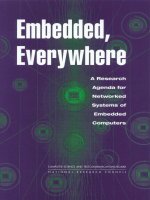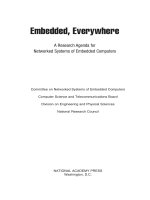Embedded, Everywhere A Research Agenda for Networked Systems of Embedded Computers doc
Bạn đang xem bản rút gọn của tài liệu. Xem và tải ngay bản đầy đủ của tài liệu tại đây (4.85 MB, 235 trang )
Embedded, Everywhere
A Research Agenda for
Networked Systems of Embedded Computers
Committee on Networked Systems of Embedded Computers
Computer Science and Telecommunications Board
Division on Engineering and Physical Sciences
National Research Council
NATIONAL ACADEMY PRESS
Washington, D.C.
NOTICE: The project that is the subject of this report was approved by the Gov-
erning Board of the National Research Council, whose members are drawn from
the councils of the National Academy of Sciences, the National Academy of Engi-
neering, and the Institute of Medicine. The members of the committee responsible
for the report were chosen for their special competences and with regard for
appropriate balance.
Support for this project was provided by the Defense Advanced Research Projects
Agency and the National Institute of Standards and Technology. Any opinions,
findings, conclusions, or recommendations expressed in this material are those of
the authors and do not necessarily reflect the views of the sponsor. Moreover, the
views, opinions, and findings contained in this report should not be construed as
an official Department of Defense position, policy, or decision, unless so desig-
nated by other official documentation.
Library of Congress Control Number: 2001093511
International Standard Book Number 0-309-07568-8
Additional copies of this report are available from:
National Academy Press
2101 Constitution Avenue, N.W.
Box 285
Washington, DC 20055
800/624-6242
202/334-3313 (in the Washington metropolitan area)
Copyright 2001 by the National Academy of Sciences. All rights reserved.
Printed in the United States of America
The National Academy of Sciences is a private, nonprofit, self-perpetuating soci-
ety of distinguished scholars engaged in scientific and engineering research, dedi-
cated to the furtherance of science and technology and to their use for the general
welfare. Upon the authority of the charter granted to it by the Congress in 1863,
the Academy has a mandate that requires it to advise the federal government on
scientific and technical matters. Dr. Bruce M. Alberts is president of the National
Academy of Sciences.
The National Academy of Engineering was established in 1964, under the charter
of the National Academy of Sciences, as a parallel organization of outstanding
engineers. It is autonomous in its administration and in the selection of its mem-
bers, sharing with the National Academy of Sciences the responsibility for advis-
ing the federal government. The National Academy of Engineering also sponsors
engineering programs aimed at meeting national needs, encourages education
and research, and recognizes the superior achievements of engineers. Dr. Wm. A.
Wulf is president of the National Academy of Engineering.
The Institute of Medicine was established in 1970 by the National Academy of
Sciences to secure the services of eminent members of appropriate professions in
the examination of policy matters pertaining to the health of the public. The
Institute acts under the responsibility given to the National Academy of Sciences
by its congressional charter to be an adviser to the federal government and, upon
its own initiative, to identify issues of medical care, research, and education.
Dr. Kenneth I. Shine is president of the Institute of Medicine.
The National Research Council was organized by the National Academy of Sci-
ences in 1916 to associate the broad community of science and technology with
the Academy’s purposes of furthering knowledge and advising the federal gov-
ernment. Functioning in accordance with general policies determined by the
Academy, the Council has become the principal operating agency of both the
National Academy of Sciences and the National Academy of Engineering in pro-
viding services to the government, the public, and the scientific and engineering
communities. The Council is administered jointly by both Academies and the
Institute of Medicine. Dr. Bruce M. Alberts and Dr. Wm. A. Wulf are chairman
and vice chairman, respectively, of the National Research Council.
National Academy of Sciences
National Academy of Engineering
Institute of Medicine
National Research Council
COMMITTEE ON NETWORKED SYSTEMS OF
EMBEDDED COMPUTERS
DEBORAH L. ESTRIN, University of California at Los Angeles, Chair
GAETANO BORRIELLO, University of Washington
ROBERT PAUL COLWELL, Intel Corporation
JERRY FIDDLER, Wind River Systems, Inc.
MARK HOROWITZ, Stanford University
WILLIAM J. KAISER, Sensoria Corporation
NANCY G. LEVESON, Massachusetts Institute of Technology
BARBARA H. LISKOV, Massachusetts Institute of Technology
PETER LUCAS, Maya Design Group
DAVID P. MAHER, InterTrust Technologies Corporation
PAUL M. MANKIEWICH, Lucent Technologies
RICHARD TAYLOR, Hewlett-Packard Laboratories
JIM WALDO, Sun Microsystems, Inc.
Staff
LYNETTE I. MILLETT, Program Officer (Study Director beginning
September 2000)
JERRY R. SHEEHAN, Senior Program Officer (Study Director through
August 2000)
SUZANNE OSSA, Senior Project Assistant
v
COMPUTER SCIENCE AND TELECOMMUNICATIONS BOARD
DAVID D. CLARK, Massachusetts Institute of Technology, Chair
DAVID BORTH, Motorola Labs
JAMES CHIDDIX, AOL Time Warner
JOHN M. CIOFFI, Stanford University
ELAINE COHEN, University of Utah
W. BRUCE CROFT, University of Massachusetts at Amherst
SUSAN L. GRAHAM, University of California at Berkeley
JUDITH HEMPEL, University of California at San Francisco
JEFFREY M. JAFFE, Bell Laboratories, Lucent Technologies
ANNA KARLIN, University of Washington
MICHAEL KATZ, University of California at Berkeley
BUTLER W. LAMPSON, Microsoft Corporation
EDWARD D. LAZOWSKA, University of Washington
DAVID LIDDLE, U.S. Venture Partners
TOM M. MITCHELL, WhizBang! Labs, Inc.
DONALD NORMAN, UNext.com
DAVID A. PATTERSON, University of California at Berkeley
HENRY (HANK) PERRITT, Chicago-Kent College of Law
BURTON SMITH, Cray, Inc.
TERRY SMITH, University of California at Santa Barbara
LEE SPROULL, New York University
MARJORY S. BLUMENTHAL, Executive Director
HERBERT S. LIN, Senior Scientist
ALAN S. INOUYE, Senior Program Officer
JON EISENBERG, Senior Program Officer
LYNETTE I. MILLETT, Program Officer
CYNTHIA PATTERSON, Program Officer
JANET BRISCOE, Administrative Officer
MARGARET HUYNH, Senior Project Assistant
SUZANNE OSSA, Senior Project Assistant
DAVID DRAKE, Project Assistant
DAVID PADGHAM, Research Assistant
BRANDYE WILLIAMS, Office Assistant
vi
Preface
C
ontinued advances in information technologies are enabling a
growing number of physical devices to be imbued with comput-
ing and communications capabilities. Aircraft, cars, household
appliances, cellular telephones, and health monitoring devices all contain
microprocessors that are being linked with other information processing
devices. Such examples represent only the very beginning of what is
possible. As microprocessors continue to shrink, wireless radios are also
becoming more powerful and compact. As the cost of these and related
technologies continues to decrease, computing and communications tech-
nologies will be embedded into everyday objects of all kinds to allow
objects to sense and react to their changing environments. Networks
comprising thousands or millions of sensors could monitor the environ-
ment, the battlefield, or the factory floor; smart spaces containing hun-
dreds of smart surfaces and intelligent appliances could provide access to
computational resources.
Getting to this point will not be easy. Networks of embedded com-
puters pose a host of challenges qualitatively different from those faced
by more traditional computers or stand-alone embedded computers be-
cause they will be more tightly integrated with their physical environ-
ments, more autonomous, and more constrained in terms of space, power,
and other resources. They will also need to operate, communicate, and
adapt in real time, often unattended. Enabling such innovation will
require that a number of research challenges be overcome. How can large
numbers of embedded computing devices assemble themselves seam-
vii
viii PREFACE
lessly into an integrated network? How can their performance be guaran-
teed? How can social issues raised by the advent of more pervasive
information collection and processing—for example, concerns about pri-
vacy, robustness, and usability—be addressed?
CHARGE TO THE COMMITTEE
To improve understanding of these issues and help guide future re-
search endeavors, the Defense Advanced Research Projects Agency
(DARPA) and the National Institute of Standards and Technology (NIST)
asked the Computer Science and Telecommunications Board (CSTB) of
the National Research Council (NRC) to conduct a study of networked
systems of embedded computers (EmNets) that would examine the kinds
of systems that might be developed and deployed in the future and iden-
tify areas in need of greater investigation. This report identifies opportu-
nities for the use of EmNets, examines the ways EmNets differ from more
traditional systems, and delineates the research topics that need to be
addressed. The objective is to develop a research agenda that could guide
federal programs related to computing research and inform the research
community (in industry, universities, and government) about the chal-
lenging needs of this emerging research area. This report examines both
issues related to components of embedded computers—such as hardware
needs, operating systems, programming capabilities, and human inter-
faces—and systems-level issues resulting from the interconnection of
multiple embedded computers—system architectures, coordination, ad-
aptation, reliability, security, safety, interoperability, stability, and guar-
anteed performance. To that end, the committee attempted to answer
questions such as the following:
• What are networked systems of embedded computing systems?
How do networks of embedded computers differ from more traditional
computer networks? How do these differences affect research needs?
• What types of applications could arise from greater networking of
embedded systems? What are the general characteristics of different ap-
plications? What would be the benefits and capabilities of such systems?
• How can systems of interconnected embedded processors be more
easily designed, developed, and maintained? How can system reliability,
safety, operability, and maintainability be ensured in networked systems?
How do such considerations differ for embedded and more traditional
forms of computing?
• What kinds of advances are needed in enabling component tech-
nologies, such as hardware devices, operating systems, and communica-
tions networks, to make EmNets possible and more capable?
PREFACE ix
• What types of user interfaces are needed to allow users to interact
with and to program systems composed of large numbers of inter-
connected embedded systems? How do these requirements differ for
different kinds of users (experts, novices, system integrators)? What types
of “programming” will consumers be expected to perform?
• How can the stability and effectiveness of interconnected systems
of embedded computers be assured if individual components come from
a wide variety of developers and use a variety of hardware and software
platforms, some of which may run the latest versions of the software, and
others of which may be several generations behind?
COMMITTEE COMPOSITION AND PROCESS
To conduct the study, CSTB assembled a committee of 15 members
from industry and academia with expertise in areas of apparent impor-
tance to EmNets, such as computing devices, very-large-scale integrated
circuit technology, networking, wireless communications, embedded op-
erating systems, software safety, distributed computing, programming
languages, human-computer interfaces and usability, and computer sys-
tem security.
1
Several committee members brought with them a familiar-
ity with federal research programs related to EmNet technologies and
provided invaluable insight into the challenges of organizing research
programs in this area. Several committee members changed their organi-
zational affiliation during the course of the study, attesting to the dy-
namic nature of this field. Indeed, because of growing commercial inter-
est in ubiquitous or pervasive computing technology, two of the original
committee members, Walter Davis from Motorola and Ajei Gopal from
IBM, were unable to continue their participation in the project.
The committee met six times between December 1999 and March 2001
to plan its course of action, solicit testimony from relevant experts, delib-
erate its findings, and draft its final report. It continued its work by
electronic communications into the spring of 2001. During the course of
the project, the committee heard from information technology researchers
in industry and universities and from directors of government agencies
involved in funding computing research (including research related to
EmNets).
2
It also met with people involved in developing and deploying
EmNets to serve a range of missions, from controlling lighting and heat-
ing systems in office buildings and automating manufacturing lines, to
1
See Appendix A for biographies of committee members.
2
See Appendix B for a list of briefers to the committee.
x PREFACE
monitoring the health of astronauts in space and of patients in emergency
rooms. The committee also gathered information on major initiatives to
pursue research on ubiquitous and pervasive computing, and it collected
data on microprocessors, microcontrollers, wireless communications
nodes, and their applications in order to track the emergence of an EmNet
environment.
ACKNOWLEDGMENTS
As with any project of this magnitude, thanks are due to the many
individuals who contributed to the work of the committee. First, thanks
are due to the members of the committee itself, who volunteered consid-
erable time during the course of the study to attend meetings, engage in e-
mail and telephone discussions, draft sections of the report, and respond
to comments from external reviewers.
Beyond the committee, numerous persons provided valuable infor-
mation through briefings to committee meetings: Andrew Berlin, Xerox
Palo Alto Research Center; Stephen P. Boyd, Stanford University; Janusz
Bryzek, Maxim Integrated Products, Inc.; David D. Clark, Massachusetts
Institute of Technology; Alan Davidson, Center for Democracy and Tech-
nology; Robert Dolin, Echelon Corporation; John Hines, National Aero-
nautics and Space Administration; Rodger Lea, Sony Distributed Systems
Laboratory; K. Venkatesh Prasad, Ford Research Laboratory; Jonathan
Smith, University of Pennsylvania; Karen Sollins, National Science
Foundation; and Keith Uncapher, Corporation for National Research
Initiatives.
Thanks are also due to those who sponsored the study. David
Tennenhouse, formerly the director of the Defense Advanced Research
Project Agency’s (DARPA) Information Technology Office (ITO) and now
vice president of research at Intel Corporation, provided the original im-
petus for the study, identifying networked systems of embedded comput-
ers as a potentially revolutionary set of technologies and laying out a
vision for the field. Shankar Sastry and Janos Sztipanovits ensured con-
tinued DARPA support for the project as they expanded ITO’s research
efforts in EmNets of different kinds. Sri Kumar, also of DARPA’s ITO,
provided considerable guidance and input related to sensor networks.
Jerry Linn, formerly of the Information Technology Lab at NIST, gener-
ated interest and financial support from several laboratories within NIST.
Other members of the Technology Policy Working Group also supported
the concept of the study, even if they did not provide financial support.
Many others also provided valuable input or services to the commit-
tee that should not go unnoted. Martin Herman and Alden Dima of NIST
provided relevant information about NIST programs near the end of the
PREFACE xi
study process. As she has done so many times in the past, Laura Ost, a
free-lance editor, provided invaluable assistance in preparing the manu-
script for review. Jim Igoe, with the National Academies library, was
helpful with background research. Craig Kaplan of the University of
Washington assisted with cover design. Jeffrey Risberg of TIBCO Soft-
ware, Inc.; Maja Mataric of the University of Southern California; Gaurav
Sukhatme of the University of Southern California; Scott Stadler of the
Massachusetts Institute of Technology’s Lincoln Laboratory; Gregory J.
Pottie of the University of California at Los Angeles; and Steven T. Sonka
of the University of Illinois at Urbana-Champaign also provided back-
ground information to the committee.
Finally, the committee would like to acknowledge the work of the
NRC staff. During the first 12 months of our study, Jerry Sheehan shaped
the content and process of the report. He contributed vision, guidance,
feedback, and discipline. Moreover, he continued to act as a key consult-
ant after his official departure. We were all quite anxious about Jerry’s
departure midway through our process; frankly, I was not sure we could
carry it off without him. However, we were tremendously pleased to find
that his replacement, Lynette Millett, was able to come in and march us to
completion without missing a beat. She ferreted out our inconsistencies,
turned our bullets into prose, implemented innumerable reorganizations
and rewrites, and last but not least, came up with the title for the report!
Lynette’s contributions are certainly embedded everywhere in this re-
port. Alan Inouye worked with Lynette behind the scenes during the
final phases of the project, providing advice and feedback and helping
shepherd the project to completion. Liz Fikre made significant editorial
contributions to the final manuscript. Claudette Baylor-Fleming, Carmela
Chamberlain, and David Padgham assisted with final report preparation.
Suzanne Ossa provided the committee with excellent support during
meetings and assisted with background research and editorial work.
Finally, we thank Marjory Blumenthal, whose vision and commitment
directly and indirectly shaped the report through her hiring and
mentoring of excellent staff and her detailed comments on many versions
of the report.
Deborah L. Estrin, Chair
Committee on Networked Systems
of Embedded Computers
Acknowledgment of Reviewers
T
his report has been reviewed in draft form by individuals chosen
for their diverse perspectives and technical expertise, in accordance
with procedures approved by the NRC’s Report Review Commit-
tee. The purpose of this independent review is to provide candid and
critical comments that will assist the institution in making its published
report as sound as possible and to ensure that the report meets institu-
tional standards for objectivity, evidence, and responsiveness to the study
charge. The review comments and draft manuscript remain confidential
to protect the integrity of the deliberative process. We wish to thank the
following individuals for their review of this report:
Michael DeWalt, Certification Services,
Batya Friedman, University of Washington,
Matthew S. Jaffe, Emory Riddle Aeronautical University,
Randy H. Katz, University of California at Berkeley,
Alan Kay, Walt Disney Imagineering,
Edward A. Lee, University of California at Berkeley,
John McHugh, CERT, Software Engineering Institute, Carnegie
Mellon University,
Kristofer S.J. Pister, University of California at Berkeley,
Rush D. Robinett, Sandia National Laboratories,
Daniel P. Siewiorek, Carnegie Mellon University, and
Andrew J. Viterbi, Viterbi Group, LLC.
xiii
Although the reviewers listed above have provided many construc-
tive comments and suggestions, they were not asked to endorse the con-
clusions or recommendations, nor did they see the final draft of the report
before its release. The review of this report was overseen by Robert J.
Spinrad, Xerox PARC (retired), appointed by the Division on Engineering
and Physical Sciences, who was responsible for making certain that an
independent examination of this report was carried out in accordance
with institutional procedures and that all review comments were care-
fully considered. Responsibility for the final content of this report rests
entirely with the authoring committee and the institution.
xiv ACKNOWLEDGMENT OF REVIEWERS
Contents
EXECUTIVE SUMMARY 1
1 INTRODUCTION AND OVERVIEW 14
Examples, 16
Example 1: Automotive Telematics, 17
Example 2: Precision Agriculture, 20
Example 3: Defense Systems, 21
Understanding Networked Systems of Embedded Computers, 24
How EmNets Differ from Traditional Systems, 26
EmNets Are Tightly Coupled to the Physical World, 27
EmNet Nodes Are Often Resource-Constrained, 28
EmNets’ Long Lifetimes, 29
EmNet Size and Scale Are Significant, 30
EmNet Users Are Not System Experts, 31
Why a New Research Agenda?, 31
What This Report Does Not Do, 33
Advanced Sensors and Actuators, 34
Public Policy Issues, 34
Commercialization Issues, Standards, Business Models, 35
Stand-alone Embedded Systems and Other Networked
Information Systems, 36
Organization of This Report, 37
References, 38
xv
xvi CONTENTS
2 ENABLING TECHNOLOGIES 39
Silicon Scaling, 40
Computing, 41
Growing Complexity, 42
Simpler Processors, 43
Power Dissipation, 45
Communication, 49
Wireline Communications, 50
Wireless Communications, 53
Geolocation, 57
Computing Software—Operating Systems and Applications, 59
Real-time and Performance-critical Aspects of Embedded
Operating Systems, 64
Microelectromechanical Systems, 65
Summary, 68
References, 73
Bibliography, 74
3 SELF-CONFIGURATION AND ADAPTIVE COORDINATION 76
Terminology, 77
Self-configuration and Adaptive Coordination in Distributed
Systems, 79
Discovery in Distributed Systems, 80
Interfaces and Interoperability, 84
Adaptive Coordination in Existing Networks, 90
Research Challenges for Configuration and Adaptive
Coordination, 93
Research Issues in Self-configuration, 93
Research Issues for Adaptive Coordination, 101
Summary, 117
References, 118
4 BUILDING TRUSTWORTHY NETWORKED SYSTEMS OF 119
EMBEDDED COMPUTERS
Reliability, 121
Reliability Research Topics Deserving Attention, 123
Safety, 123
Safety Research Topics Deserving Attention, 126
Security, 128
Protecting System Boundaries, 129
Managing Scale and Complexity, 130
Mobile Code and Security, 131
CONTENTS xvii
Denial of Service, 132
Security Research Topics Deserving Attention, 133
Privacy, 134
Privacy As Related to Security, 137
Privacy Research Topics Deserving Attention, 138
Usability, 140
Creating Mental Models, 141
EmNet-Specific Usability Issues, 143
Usability Research Topics Deserving Attention, 144
References, 145
Bibliography, 146
5 MODELS OF COMPUTATION 147
What Are Models of Computation?, 149
Distributed Computing Models: Current Practice, 152
New Models for Networked Systems of Embedded Computers, 156
Models with Resource Constraints, 158
Models Dealing with Failures, 160
New Data Models, 162
Models of Trust, 165
Models for Concurrency, 165
Models of Location, 167
Conducting Research on Models and Abstractions, 168
References, 171
6 CONCLUSIONS AND RECOMMENDATIONS: 172
AN AGENDA FOR RESEARCH
An EmNet-specific Research Agenda, 174
Predictability and Manageability, 175
Adaptive Self-configuration, 176
Monitoring and System Health, 177
Computational Models, 178
Network Geometry, 179
Interoperability, 180
Integration of Technical, Social, Ethical, and Public Policy
Issues, 181
Enabling Technologies, 183
Structuring the Research Enterprise for EmNets, 184
Stimulating Interdisciplinary Research, 185
What Can Government Do? Recommendations to Federal
Agencies, 189
xviii CONTENTS
Recommendations to the Defense Advanced Research
Projects Agency, 190
Recommendations to the National Institute of Standards and
Technology, 197
Recommendations to the National Science Foundation, 199
Recommendations to Other Federal Agencies, 201
Summary, 202
References, 202
APPENDIXES 205
A Biographies of Committee Members 207
B Briefers at Plenary Meetings 214
Embedded, Everywhere
A Research Agenda for
Networked Systems of Embedded Computers
1
Executive Summary
I
nformation technology (IT) is on the verge of another revolution.
Driven by the increasing capabilities and ever declining costs of com-
puting and communications devices, IT is being embedded into a
growing range of physical devices linked together through networks and
will become ever more pervasive as the component technologies become
smaller, faster, and cheaper. These changes are sometimes obvious—in
pagers and Internet-enabled cell phones, for example—but often IT is
buried inside larger (or smaller) systems in ways that are not easily visible
to end users. These networked systems of embedded computers, referred
to as EmNets throughout this report, have the potential to change radi-
cally the way people interact with their environment by linking together a
range of devices and sensors that will allow information to be collected,
shared, and processed in unprecedented ways. The range of applications
continues to expand with continued research and development. Examples
of ways in which EmNets will be applied include the following: EmNets
will be implemented as a kind of digital nervous system to enable instru-
mentation of all sorts of spaces, ranging from in situ environmental moni-
toring to surveillance of battlespace conditions; EmNets will be employed
in personal monitoring strategies (both defense related and civilian), com-
bining information from sensors on and within a person with information
from laboratory tests and other sources; and EmNets will dramatically
affect scientific data collection capabilities, ranging from new techniques
for precision agriculture and biotechnological research to detailed envi-
ronmental and pollution monitoring.
2 EMBEDDED, EVERYWHERE
The use of EmNets throughout society could well dwarf previous
milestones in the information revolution. The effects of Moore’s law
1
and
related trends in computing and communications are making all of this
possible. Ongoing work in microelectromechanical systems (MEMS) will
enable sensing and actuation on the scale of a nanometer. The possibili-
ties for miniaturization extend into all aspects of life, and the potential for
embedding computing and communications technology quite literally
everywhere is becoming a reality. IT will eventually become an invisible
component of almost everything in everyone’s surroundings.
WHAT IS DIFFERENT ABOUT EMNETS?
EmNets are more than simply the next step in the evolution of the
personal computer or the Internet. Building on developments in both
areas, EmNets will also be operating under a set of constraints that will
demand more than merely incremental improvements to more traditional
networking and information technology. EmNets will tend to be tightly
coupled to the physical world. Unlike a desktop computer, which is itself
a piece of office furniture, EmNets will be integrated into furniture and
other objects in the environment. Individuals will interact with the ob-
jects and devices of which EmNets are a part, but it is unlikely that they
will think of it as interacting with a computer system. A complex, net-
worked, computational system will often be invisible when things are
working properly.
EmNet components will also be highly resource constrained. In con-
trast to the Internet, which still consists primarily of tethered devices,
EmNet components are likely to be small, untethered devices operating
under physical constraints such as limited energy and the need for ad-
equate heat dissipation. EmNets will also be constrained by bandwidth
and memory limitations.
In addition to the physically coupled, resource-constrained nature of
these systems, another constraint on EmNets is the fact that often they
will be integrated into objects or systems that are likely to last for long
periods of time. EmNets in buildings, bridges, vehicles, and so on will be
expected to last as long as the objects in which they are embedded. This
expectation of longevity will need to be taken into account when design-
ing, deploying, and managing these systems. A further constraint is the
1
Moore’s law refers to the observation by Gordon Moore in 1965 that each new micropro-
cessor contains roughly twice as much capacity as its predecessor, and each chip is usually
released within 18 to 24 months of the previous chip. As this trend has continued, comput-
ing power has risen exponentially.
EXECUTIVE SUMMARY 3
likely heterogeneity and large number of interacting elements that will
make up an EmNet; this makes interoperability a key concern. Finally,
EmNets will often be used and interacted with by people who are not
experts in EmNet-related technology. Managing all of these constraints
and creating a system that functions properly for the application domain
while remaining understandable and manageable by human operators,
users, and—in many cases—casual passersby, is a large challenge for
EmNet designers.
As an example, consider a transportation information system based
on EmNet technology. Such a system will certainly be large in size and
scale, possibly encompassing the entire highway system of the United
States. Components of it would probably be embedded in long-lived
physical structures (such as bridges, traffic lights, individual cars, and
perhaps even the paint on the roads). Some components will be tethered,
but many would be resource constrained while computing data and com-
municating it wirelessly when necessary. The many pieces of such a
system will of necessity be heterogeneous, not only in form but also in
function. There may be subsystems that communicate to consumers in
private vehicles, others that relay information from emergency vehicles to
synchronize traffic lights, still others that provide traffic data and analysis
to highway engineers, and perhaps some that communicate to law en-
forcement. Issues of how information will be communicated to those
interacting with the system are of great importance in such an environ-
ment. Safety is a critical concern; issues of privacy and security arise as
well, along with concerns about reliability.
The rest of this report identifies areas in which research is needed to
enable such EmNets and to make them a successful reality. Below are
highlights of some of these areas as well as particular recommendations
to federal funding agencies.
KEY AREAS OF INQUIRY
Realizing the great promise of EmNets requires more than the mere
advance of individual technologies—it will rely on numerous subsystems
working together in an efficient, unattended, comprehensible, and trust-
worthy manner. Many aspects of the needed research are highly interdis-
ciplinary because of the intricate ways in which EmNet systems interact
with the physical world. In the absence of programs aimed at solving
some of the basic research problems, it is likely that many of the benefits
of EmNets will simply not be realized.
As with any technology there are risks. In the case of EmNets, the
potential benefits come with associated risks that may be exacerbated by
the EmNets’ very pervasiveness. Pervasive information creates security,
4 EMBEDDED, EVERYWHERE
safety, and privacy protection issues. As EmNets become increasingly
critical to our communication, transportation, power distribution, and
health-care infrastructures, the consequences of failures and security
breaches will become increasingly severe. By the time EmNets are broadly
deployed, it may not be feasible to give them technological fixes because
their components are so widely dispersed.
This report by the Committee on Networked Systems of Embedded
Computing, convened by the Computer Science and Telecommunications
Board of the National Research Council, identifies and explores the many
research questions that must be answered before there can be implemen-
tation and use of widespread networked embedded computing devices.
It examines the enabling technologies that will facilitate the development
and broad deployment of EmNets, and it explores three key areas in
which a great deal of new research will be required for EmNets to achieve
their full potential: (1) self-configuration and adaptive coordination,
(2) building trustworthy EmNets (including issues of privacy, security,
reliability, safety, and usability), and (3) models of computation. Enabling
technologies and these key areas of research, explored in depth in Chap-
ters 2, 3, 4, and 5, are briefly described below.
Self-configuration and Adaptive Coordination
Given the expected pervasive and ubiquitous nature of EmNets, it
will be necessary for these systems to be able to configure themselves and
adapt to their environments automatically. Self-configuration and adaptive
coordination comprise a spectrum of changes that a system makes to itself
in response to occurrences both internal to it and external. EmNets will
be relatively long lived, which greatly increases their chances of being
upgraded, extended, and otherwise modified. Moreover, EmNets will be
exposed to both continual environmental and component dynamics. In
effect, the original EmNet must be designed with automatic reconfigura-
tion and adaptation in mind, especially when the specifics of that recon-
figuration cannot be known at design time. Current work in distributed
systems has not solved the problem of systems operating under the con-
straints that networked systems of embedded computers will experience,
particularly with respect to computational resources, communication limi-
tations, and energy restrictions.
Self-configuration is the process of interconnecting available elements
into an ensemble that will perform the required functions at the desired
performance level. Self-configuration in existing systems is evidenced by
the notions of service discovery, interfaces, and interoperability. In this
report, the research challenges related to self-configuration focus on mo-
bile code and discovery. EmNets present a number of constraints: They
EXECUTIVE SUMMARY 5
will appear in hybrid environments of mobile and static networks; their
nodes will be diverse in capability, energy availability, and quality of
connectivity; the wireless layer is both diverse and limited by energy
constraints, making low power discovery a challenge. Some of the issues
that will need to be investigated and resolved for configuration and adap-
tation to succeed in EmNets include stable localized control, abstraction,
and memory use. Research issues related to service discovery include the
scaling of discovery protocols, security, and the development of adequate
failure models for automatically configured networks.
Adaptive coordination involves changes in the behavior of a system
as it responds to changes in the environment or system resources. Coor-
dination will not be mediated by humans because EmNets are so large
and the time scale over which the adaptation will need to take place is too
short for a human to be able to intervene. Achieving adaptive coordina-
tion in EmNets will not only require drawing on the lessons learned from
adaptive coordination in existing distributed systems, but it will also re-
quire meeting the radical new challenges of EmNets that are due to the
physically embedded nature of the collaborative control tasks and the
massive numbers of elements, all combined with the relatively con-
strained capabilities of individual elements. Adaptive coordination is a
fairly new area of investigation, particularly as it applies to EmNets. To
obtain necessary adaptability in EmNets, research is needed in three ar-
eas: exploiting massive redundancy to achieve system robustness and
longevity, decentralized control, and collaborative processing.
Building Trustworthy EmNets
EmNets will be deployed in large numbers and will become an essen-
tial part of the fabric of everyday life. In the same way that people often
assume that electric power and telephone service will be available (recent
events in California notwithstanding), they will assume the availability
and proper functioning of EmNets. But in contrast to those utility ser-
vices, EmNets will be deployed in situ, often without the dedicated expert
service and maintenance associated with utilities, making the trustwor-
thiness of EmNets triply difficult: EmNets are real-world systems, often
directly affected by wind, weather, and interference; they must embody
the redundancy needed for dependability without compromising the ba-
sic economics, and they must adequately and safely convey to a nonex-
pert user how much of that redundancy is available (thereby determining
the system’s safety margins) so that users can make reasonable decisions
concerning their use. This report discusses five features that must be
addressed in the design of EmNets from the outset: reliability, safety,
security, privacy, and usability.









